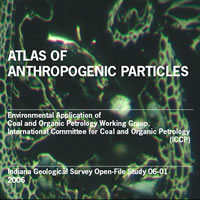Environmental Application of Organic Petrology
| January 29, 2013 | Filled under Com III |
|
established in 1993 (Crete)
Conveners
Members
The Environmental Application of Organic Petrology Working Group was formed at the 45th Annual Meeting of the ICCP held at Chania, Crete, Greece in 1993.
Objectives

Front Page of the Atlas of Anthropogenic Particles
The original objectives of the Working Group under A. Depers & J. Bailey guidance were:
- to review case studies where organic petrology has helped to solve environmental problems;
- to compile information on methods and instrumentation used in case studies, with the ultimate aim of producing a standard procedures document; and
- to assemble a bibliography of published papers, unpublished open file reports, abstracts from symposia, and unpublished data into a “user-friendly” and accessible format (for example, as an ASCII computer file or converted to a commonly used word processor language).
Additional objectives developed between 2000-2006 under M. Mastalerz guidance were as follows:
- to develop a classification scheme of anthropogenic matter that could be helpful in petrographic characterization of different types of systems that are either produced or affected by industrial/human activity (fly ash, soil/sediment, water, air); and
- to prepare a digital atlas of anthropogenic particles from different sources. The main purposes of this atlas are to: a) help identification of anthropogenic particles under microscope, and b) to help identify the source of the anthropogenic particles.
The Atlas was completed in 2006 and is available for purchase from ICCP.
Following publication of the Atlas of Anthropogenic Particles in 2006 the proposed activities of the WG were:
- It is essential to test the applicability of the Atlas of Anthropogenic Particles by examining more samples of an anthropogenic nature. The new editions of the Atlas may include future input of information in the current body of work as the results of exchange and classification of the available data by participating associates.
- Organic carbon forms a significant portion in the global cycling of carbon. Furthermore, recent findings suggest that organic matter play an important role in distribution and accumulation of hazardous substances such as mercury, other heavy metals, and Persistent Organic Pollutants (POPs). Therefore, there is an increasing demand for studying the organic matter in recent surface deposits, riverine systems, lacustrine and marine environment. In conjunction with various geochemical techniques, the optical characterizations of the recent organic matter will play an important role in documenting and source apportionment of organic carbon in these systems.
Activities
Reports and materials available:
- White Paper. Edited and compiled by A.M. Depers and J. G. Bailey in 1994 (ICCP archival material, please contact Dr. Deolinda Flores)
- Bibliography on Environmental Applications of Organic Petrology. Compiled by J.C. Crelling, A.M. Depers, J.C. Hower, M. Mastalerz, M. Glikson, and P.K. Mukhopadhyay in 2001 (ICCP archival material, please contact Dr. Deolinda Flores)
- Atlas of Anthropogenic particles. The main purpose of this atlas is to help to identify and describe anthropogenic particles from any environment or site of deposition and determine their source. To serve this purpose, images are grouped into two sections:1) anthropogenic particles classified by source, including particles from well-defined sources (for example, power plants, coke plants)
2) anthropogenic particles classified by the site of their occurrence (for example, soil, air, water).The atlas includes 543 images compiled from 2002 to 2005. Most images were taken under a reflected light microscope (both with dry objective and in oil), although some images are included from scanning electron microscopes (SEM) and transmission electron microscopes (TEM). Only images from well-defined sources are included in the atlas, but the details of each description vary, depending upon the level of confidentiality related to the source.
At the 2008 ICCP Annual Meeting the convener reviewed the activities carried out over the years and made some proposals for future work. Possible actions for the future are:
- testing the applicability of the classification to study environmental samples, focusing on the study of unconsolidated sediments
- preparing a special volume to be published in a peer-reviewed journal about the various applications of organic petrology in environmental issues,
- adding to the atlas some guidelines to help to classify the particles.
The Environmental Applications of Organic Petrology working group was closed at the 2011 ICCP meeting in Porto. Hamed Sanei reviewed the working group activities at that time and made some specific suggestions for future work:
- to broaden the material in the Atlas of Anthropogenic Particles to include more international localities.
- to summarize in table format recently published environmental studies which included organic petrology applications.
- to host a dynamic database (summary table of environmental studies including organic petrology applications) from the working group webpage.
The Environmental Applications of Organic Petrology working group is now closed. Potential new conveners or working group members interested in reopening the activities of the WG are encouraged to contact the Commission II Chair or Secretary.
